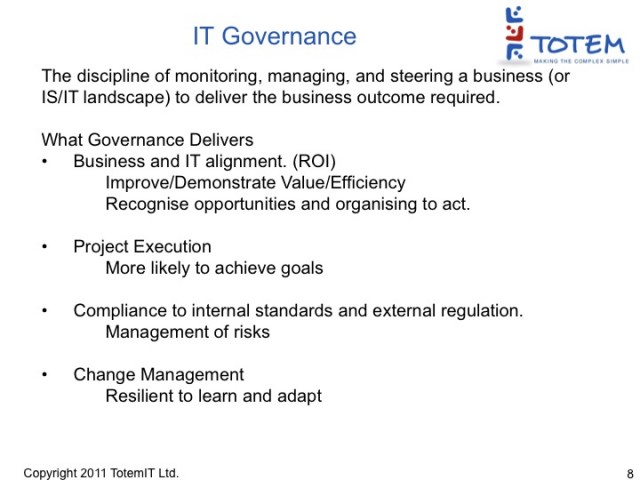At its highest level, governance, like it sounds is synonymous with government. The institution which manages a set of processes, structures and boundaries within which a country operates. Business and IT governance have similar aims but are focused on oversight and ensuring that strategies and regulations are implemented, and that services and resources are effectively and efficiently managed.
Perhaps the most obvious learning we can take from comparing IT governance with government is its importance. Without good governance an organisation carries a high risk of failure. A simple example of the impact of poor governance is the recent inappropriate use of expenses by MP’s .
The immediate media focus concentrated on how the money had been spent but the true issue was that of governance.
Were the appropriate structures, processes, and boundaries in place to oversee and prevent these excesses from ever taking place?
No!

Contrary to popular belief governance does not have to be a cumbersome, heavy handed set of stifling rules that can bring a company to a standstill. In essence it should reflect the principles on which the company operates and influence changes in behaviour to continually minimise the need for governance. I.e. if governance is done well you should see the number of governance issues reducing.
As a startup speed, agility and creativity are key, and the governance layer is appropriately thin. When the organisation is small communication is easy, and simple, frequent conversations can be all that’s needed.
The medium sized company typically needs to balance risk, change and service management with the growth and innovation of the startup it came from. Creating a consistent, repeatable customer experience and managing costs while keeping an eye on creating an environment which is putting in place the foundations for continued long term expansion.
The large company has already proven its got the right ingredients, however often the market place can change faster than the organisation. Large organisations typically are either:
- Established companies; which are facing significant challenges as the market place evolves around them. Facing the challenges of change, governance can break under the pressure’s put upon it.
- Established companies who have realised that the market has changed and have to strictly manage cost and milk declining legacy products while migrating capability from legacy systems to new platforms and creating new offerings while managing disparate information and a multitude of replicated legacy systems.
- Shooting stars; previously medium sized companies which have seen rapid growth and have not yet had the opportunity to evolve. In order to ensure they become more successful governance needs to tuned or re-aligned for the newer, larger more complex organisation.